
Containment solutions should fit the unique needs of the data center
The criticality of the role of the data center enhances the need for data center solutions that can ensure sufficient cooling, effective airflow management, and agile functionality of the data center hosting critical equipment and servers.
Need for containment solution
Containment solution comes as a robust data center solution that is used to separate cold air supply from the hot exhaust air released from the equipment to stabilize the data center’s temperature while improving the equipment’s efficiency and performance. The containment solution also reduces energy consumption, improving the data center’s agility.
Now, while offering a containment solution, data centers opt for hot and cold aisle containment to reduce operational costs while increasing cooling efficiency. According to secondary research, about 80% of data centers have already implemented either hot or cold aisle containment. It is the most effective and comprehensive solution to ensure efficient airflow.
The Cold Aisle Containment (CAC) solution ensures a uniform flow of cold air to keep the temperature of mission-critical equipment stable. It surrounds the cold aisle with a ceiling panel right above the aisle in between racks and doors. This ensures the cold air is contained and flows through the air inlet ducts through the perforated floor tiles in front of the cabinets. In addition, the sealing of the CAC prevents hot air from reaching the server.
The Hot Aisle Containment (HAC) solution channelizes the hot air released from the equipment to the cooling equipment through a duct while ensuring that the hot air doesn’t impact the overall thermal condition of the server room. Here, it is essential to mention the critical role of airflow management in identifying hot spots and eliminating them, same with a controlled supply of cold air.
Airflow management: It’s offering for the data center solution
The airflow management in a data center monitors and maintains air temperature and pressure to identify and prevent thermal damage to the server and equipment. This is done by isolating hot and cold airstreams by forming a cold aisle and arranging the servers facing each other across the aisle. This reduces the recirculation of hot air and forms the initial phase of airflow management, where the mixing of hot and cold air within the data center ecosystem is prevented.
Simple initiatives can enhance the airflow dynamics of a data center. For example, planned airflow management can reduce server inlet temperatures and increase the CRAC (computer room air conditioner) return air temperature. This will improve cooling efficiency. However, since the modus Operandi varies among data centers, the airflow management strategy must be part of the data center solution.
With the zeal to offer a comprehensive data center solution, Netrack designed the airflow management solution as per the problems bifurcated into five zones such as;
Raised floor: Cold air leakage and cable damage due to uneven tiles
Inside the rack: Mixing of hot and cold air due to irregular cutouts through which cables pass
Brush modules and air divert kits: Certain devices have side airflow rather than standard front to rear, creating airflow management issues if not managed appropriately.
Containment solutions: Mixing of hot and cold air within a rack.
The following are the solutions for the issues.
- Brush Tile: It will reduce cold air leakage and cable damage.
- Plinth: When placed on the plinth, the racks empowered with an air seal kit, blanking panels, and brush modules reduce the chance of mixing hot and cold air.
- Brush Module: It is added to the rack’s top, bottom, and side panels with an air seal kit to avoid airflow leakage. Hence, ensure a consistent flow of cold air through the servers.
- Air Seal Kit: The air divergent kit blocks unwanted cold or hot air from entering through the vent and ensures cold air suction from the front while hot air exhausts at the back.
- Blanking Panels: These filler panels or rack spacers are installed in server racks to prevent mixing hot and cold air.
Hence, securing all data centers with the above for enhanced airflow management.
Choose wisely!
To ensure efficient airflow management in a server room full of cables, Cold and Hot air containment is used. Netrack understands the varying data center needs based on their physical size and networking equipment hosting capacity. In a small data center, the number of racks, equipment, and cables is less – which denotes less complication in terms of heat generation and energy usage. Hence, it can be mentioned that hot aisle containment is a perfect containment solution for a small data center to prevent equipment failure and overheating issues. In addition, the hot Aisle Containment (HAC) solution is an environmentally friendly and cost-efficient solution.
However, large data centers with the capacity to host several racks and servers that also have an option to add more cabinets in the future will require a cold aisle containment solution to minimize the risk of mixing hot with cold air and eventually reduce equipment downtime. The Cold Aisle Containment (CAC) solution guarantees rack-level cooling with easy deployment.




